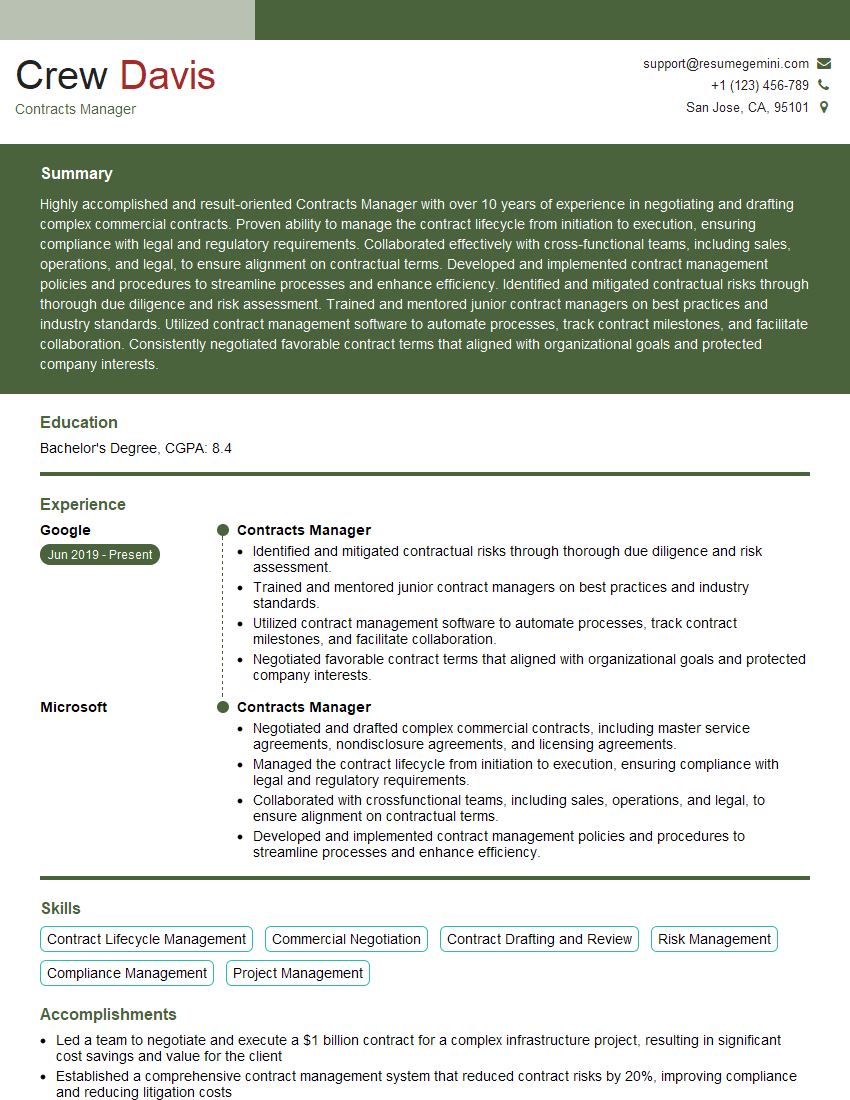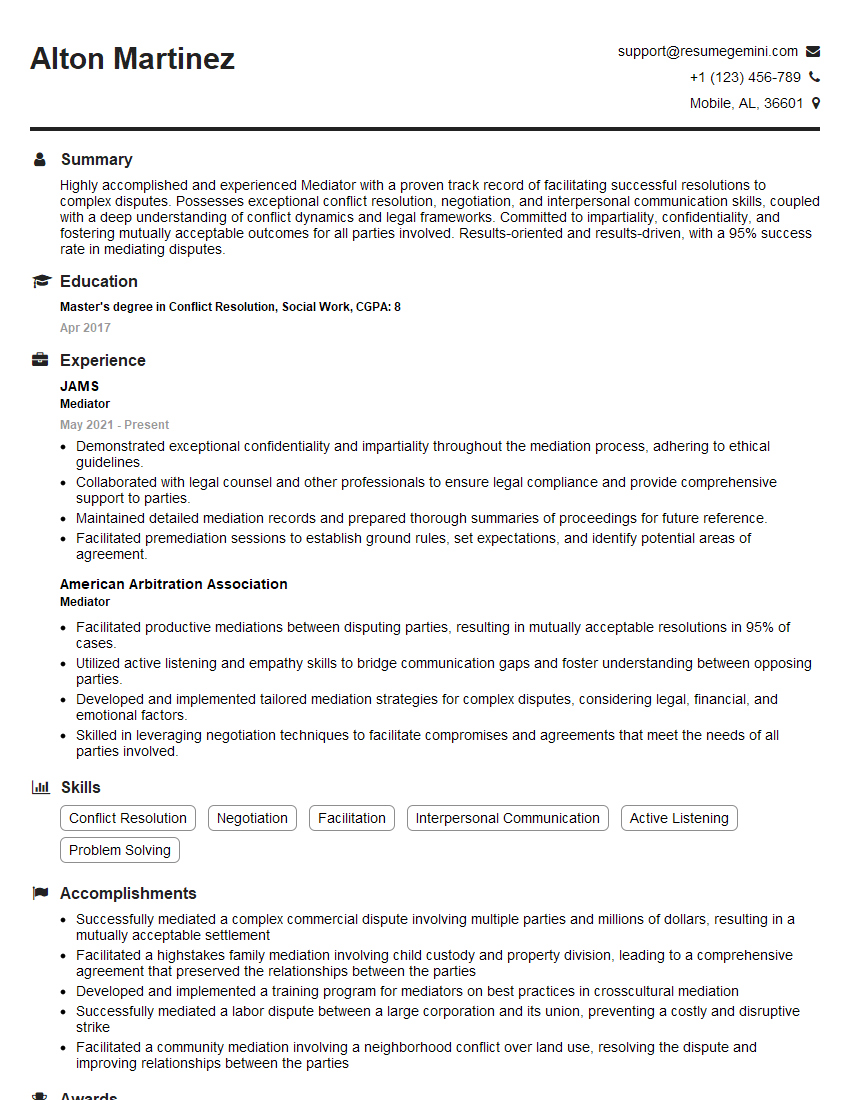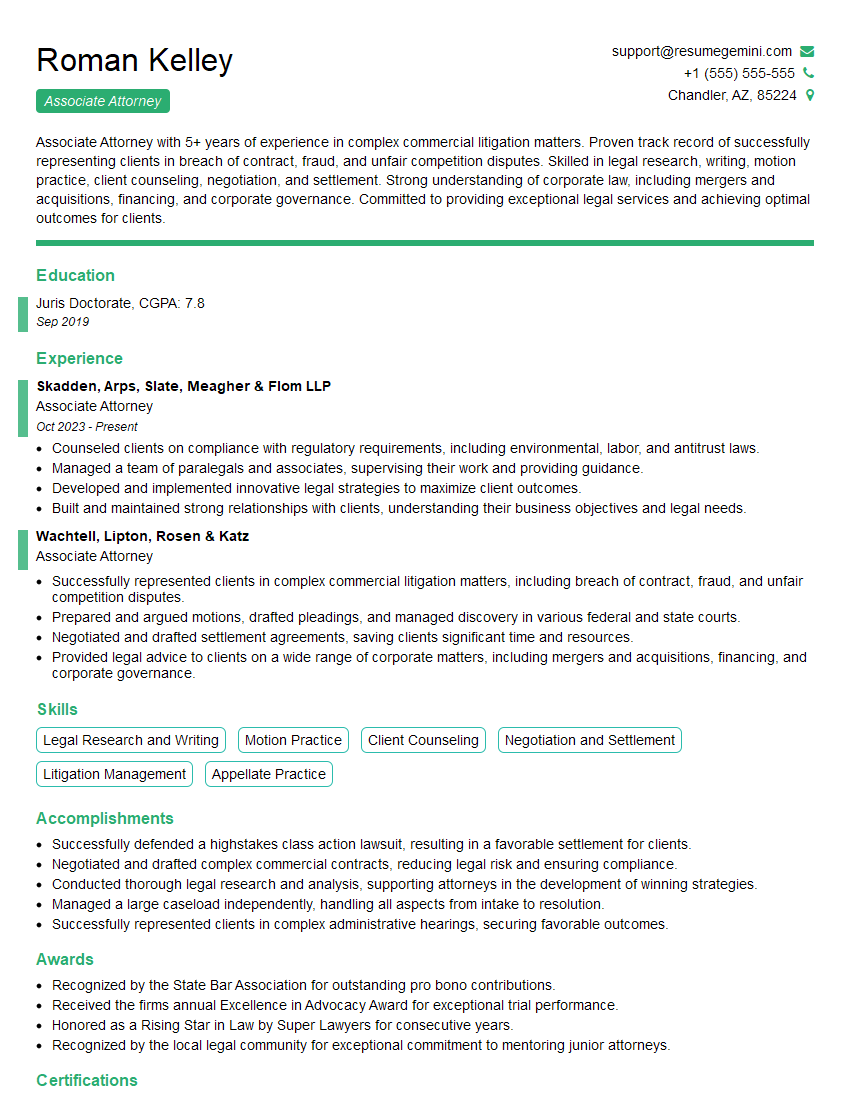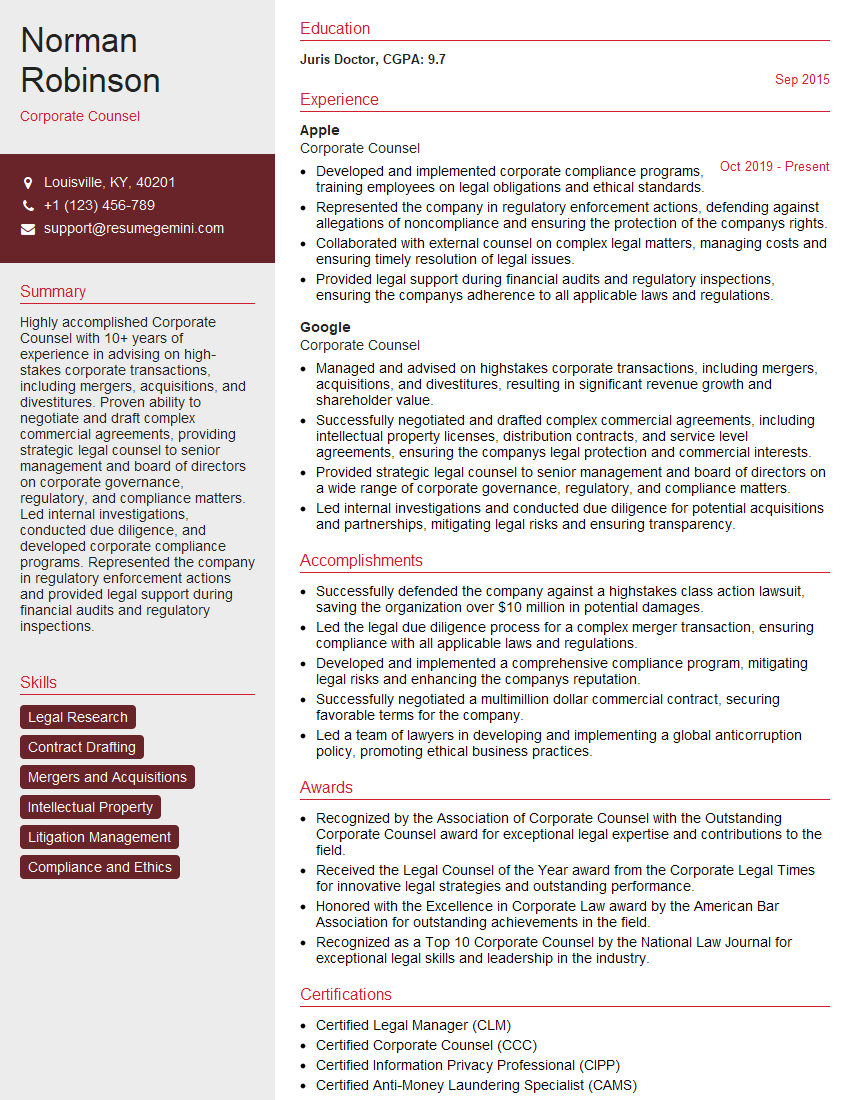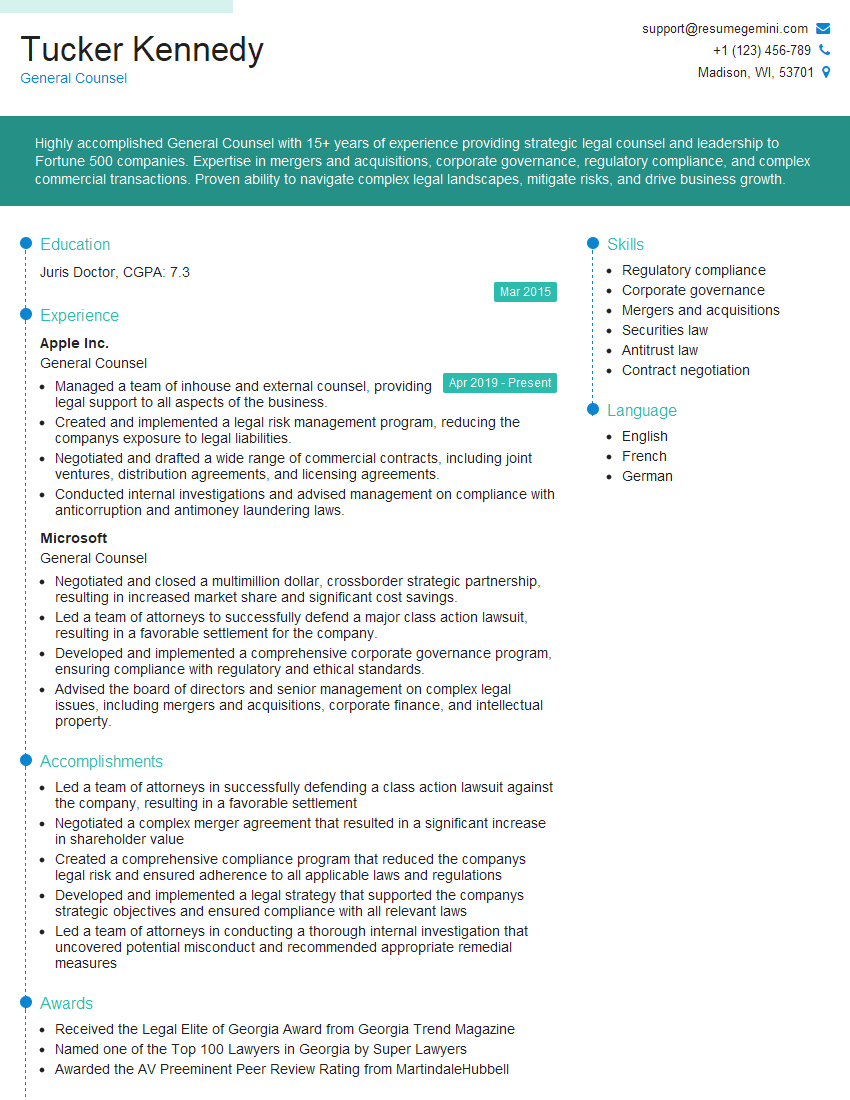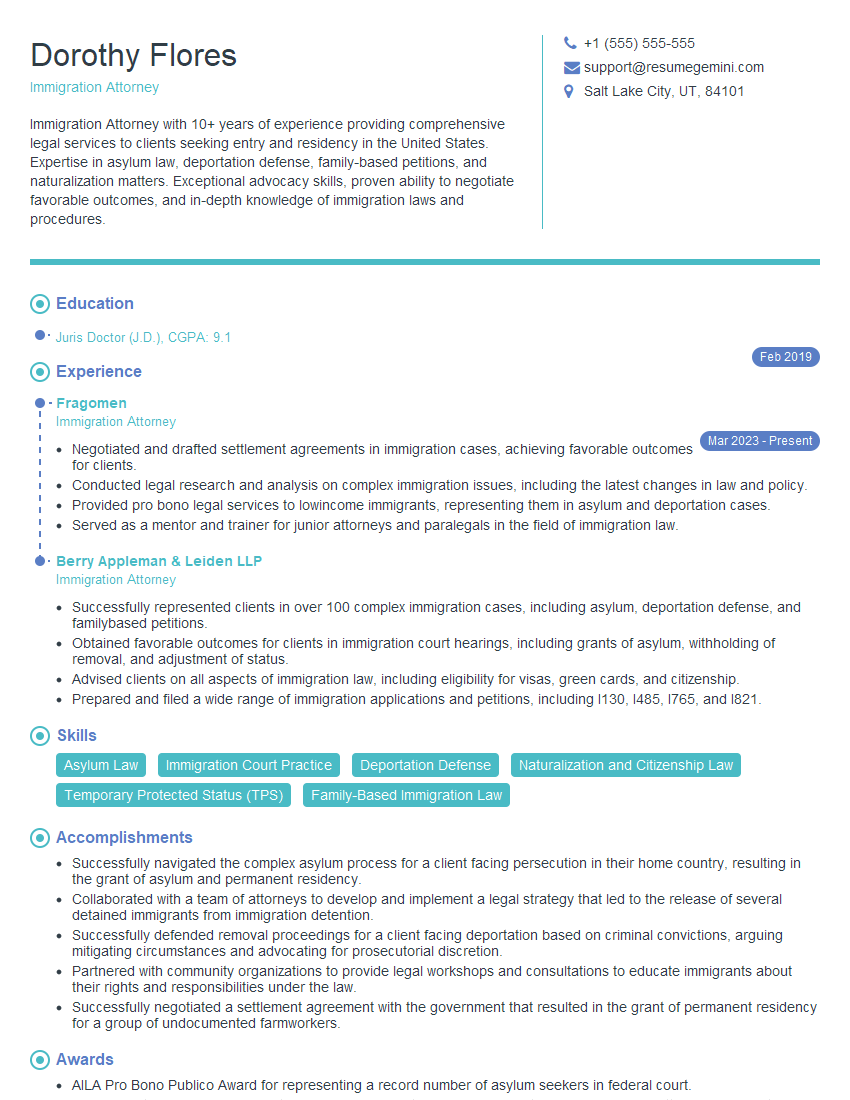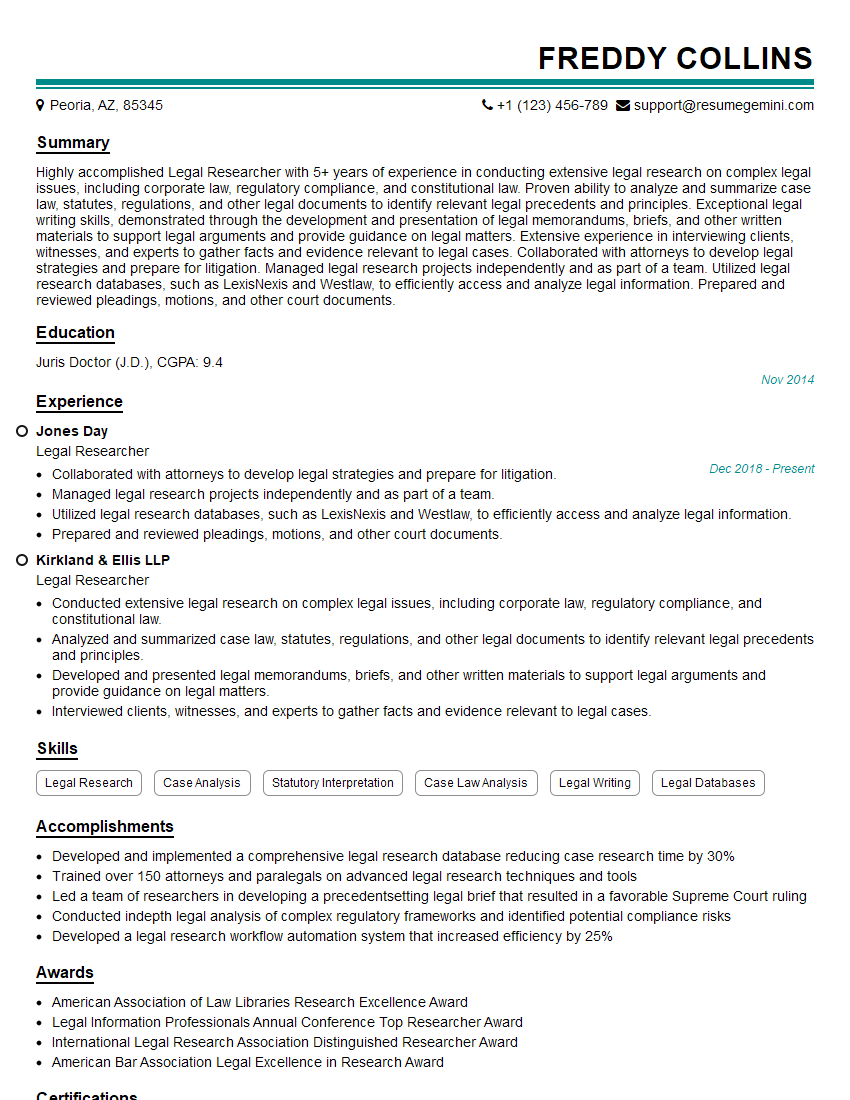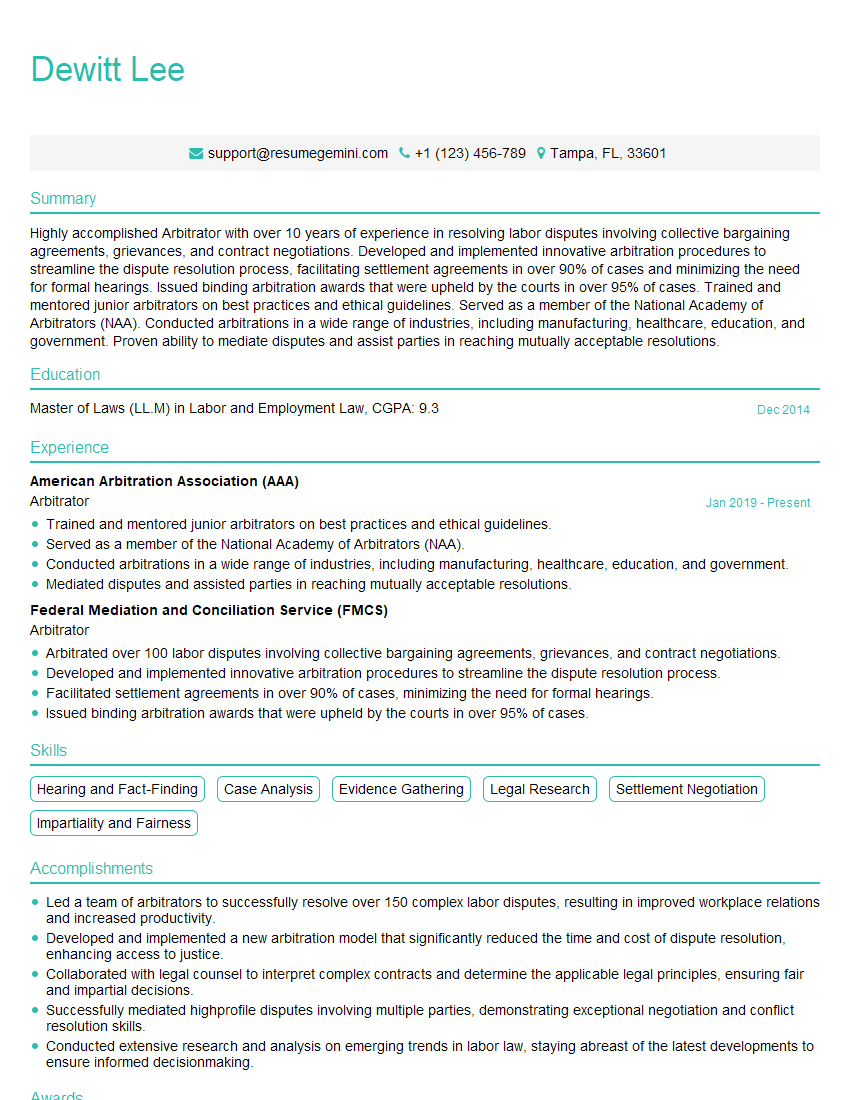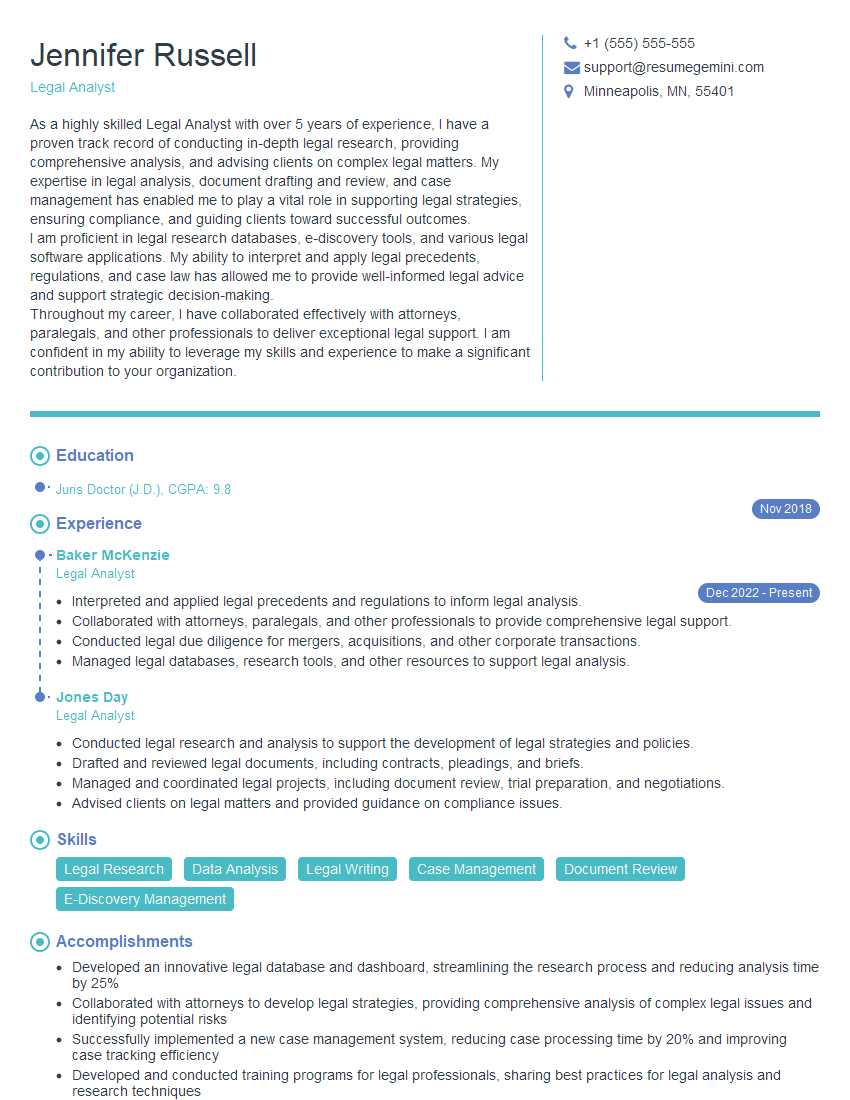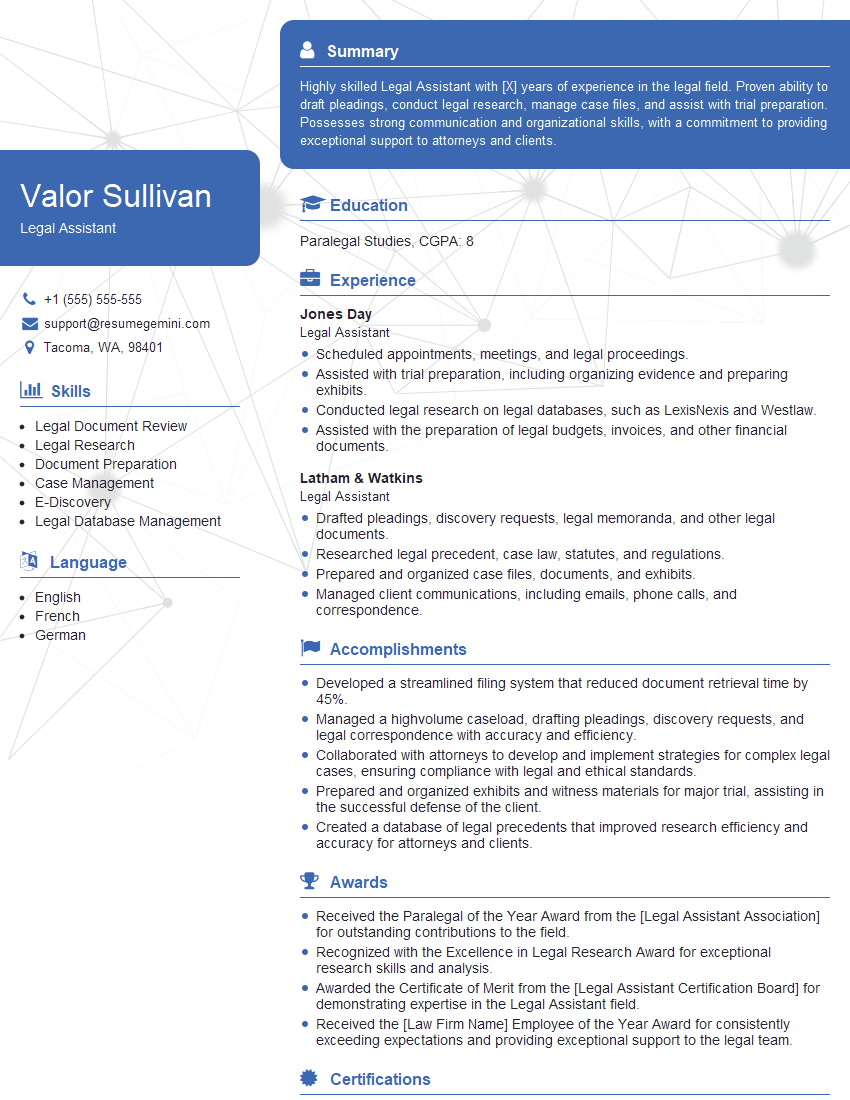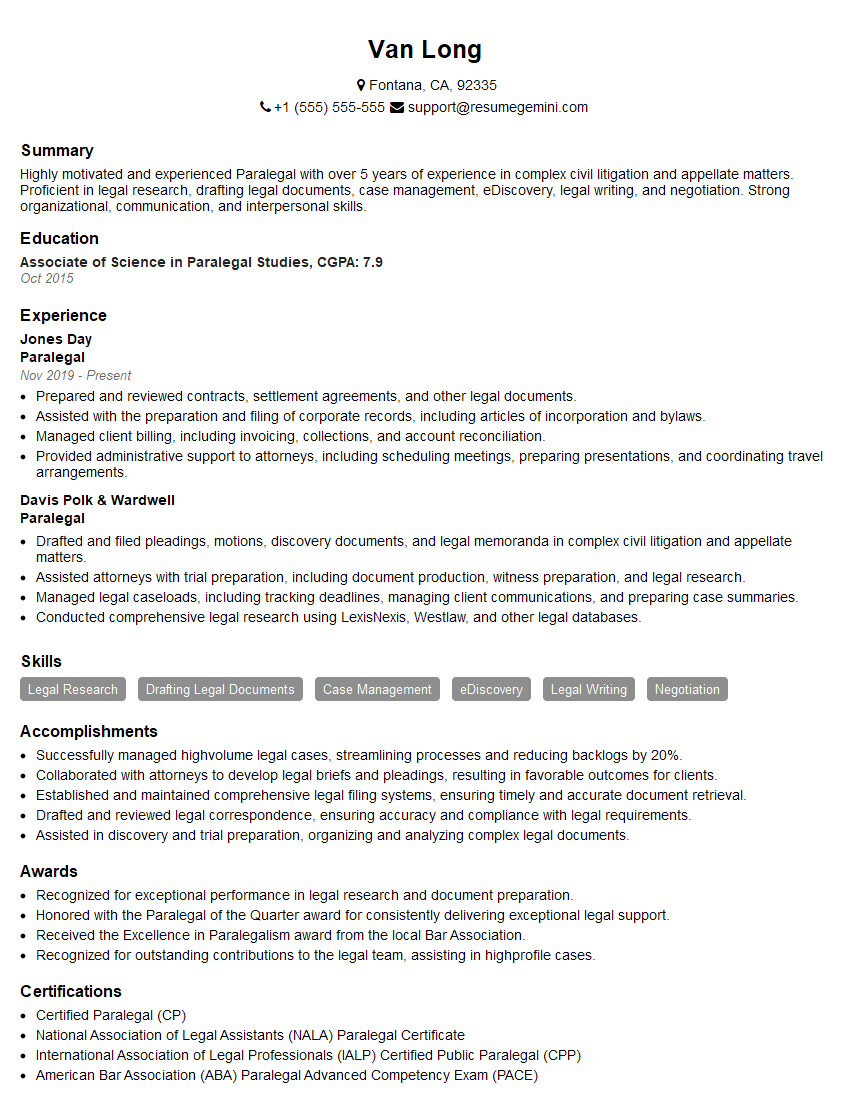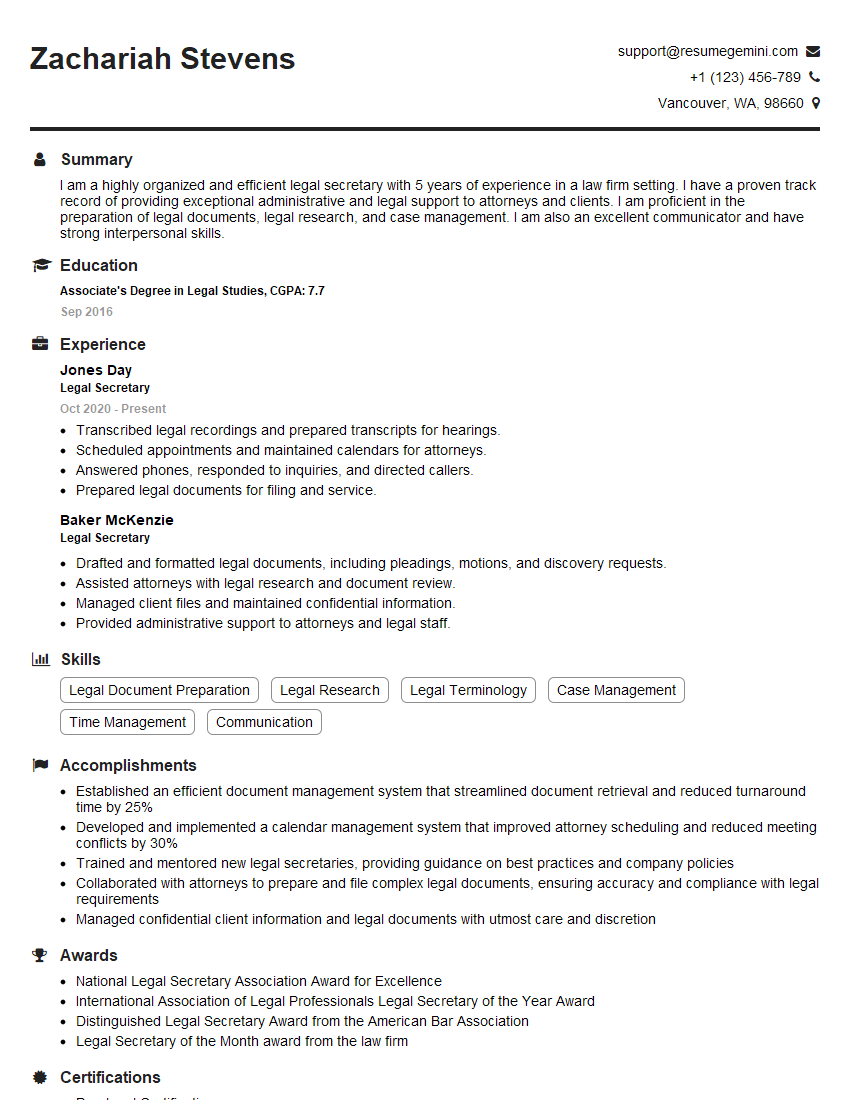The thought of an interview can be nerve-wracking, but the right preparation can make all the difference. Explore this comprehensive guide to Knowledge of American Legal System interview questions and gain the confidence you need to showcase your abilities and secure the role.
Questions Asked in Knowledge of American Legal System Interview
Q 1. Explain the difference between civil and criminal law.
Civil and criminal law are two distinct branches of the American legal system, differing significantly in their purpose, procedures, and consequences. Criminal law concerns actions that are considered harmful to society as a whole. The government prosecutes these cases, aiming to punish offenders and deter future crimes. Examples include murder, theft, and assault. The burden of proof is significantly higher – beyond a reasonable doubt. Civil law, conversely, deals with disputes between individuals or entities, where one party seeks compensation or a remedy for a wrong done. Examples include breach of contract, negligence (leading to personal injury), and property disputes. The burden of proof is lower – preponderance of the evidence.
Think of it this way: criminal law is about punishing wrongdoing against the public, while civil law is about resolving private disputes and making wronged parties whole.
Q 2. Describe the process of filing a lawsuit in federal court.
Filing a lawsuit in federal court involves several steps. First, you must establish subject matter jurisdiction; meaning the federal court has the authority to hear the case (e.g., cases involving federal laws, diversity jurisdiction where parties are from different states and the amount in controversy exceeds a certain threshold). Next, you must determine personal jurisdiction; the court must have power over the defendant (e.g., through residency or business activities within the state). Then, you file a complaint, a formal document outlining the claims against the defendant. This complaint is then served on the defendant, who is required to file an answer. The process involves discovery, where both sides exchange information and evidence. If the case doesn’t settle, it proceeds to trial, where a judge or jury will hear the evidence and render a verdict.
For example, if a citizen of New York sues a citizen of California for breach of contract exceeding $75,000, this could potentially fall under federal diversity jurisdiction, triggering the process outlined above. Each step involves strict procedural rules and deadlines outlined in the Federal Rules of Civil Procedure.
Q 3. What are the different types of alternative dispute resolution?
Alternative Dispute Resolution (ADR) offers methods to resolve disputes outside of traditional court litigation. Mediation involves a neutral third party (mediator) facilitating communication between parties to reach a mutually agreeable solution. The mediator doesn’t impose a decision; instead, they guide the parties to find common ground. Arbitration is more formal, with an arbitrator hearing evidence and issuing a binding decision. This decision is generally legally enforceable. Negotiation is a direct discussion between the involved parties, without a third party, aimed at reaching a settlement. Each method offers advantages depending on the specific dispute and relationship between the parties.
Imagine a landlord-tenant dispute over a security deposit. Negotiation might be the first attempt. If that fails, mediation could help them find a compromise. If a final agreement is unattainable, arbitration might be the next step, potentially leading to a binding decision on the deposit’s return.
Q 4. Explain the concept of precedent and stare decisis.
Precedent refers to prior judicial decisions that serve as guides for resolving similar cases in the future. Stare decisis, Latin for “to stand by things decided,” is the doctrine that courts should follow precedents set by higher courts within the same jurisdiction. This principle promotes consistency and predictability in the application of the law. However, courts can overturn precedent if it’s deemed incorrect or outdated, though this is usually done cautiously.
For example, the landmark Supreme Court case Brown v. Board of Education overturned precedent that upheld racial segregation in schools, establishing a new precedent for equal educational opportunities.
Q 5. What are the key differences between state and federal court systems?
The American legal system is a dual system, comprised of federal and state courts. Federal courts hear cases involving federal laws, treaties, and the U.S. Constitution. They also handle cases involving diversity of citizenship (as discussed earlier). State courts handle the vast majority of cases, covering state laws, most crimes, and many civil disputes. Federal judges are appointed by the President and confirmed by the Senate, while state judges are typically elected or appointed through state processes. The structure and jurisdiction of federal and state courts differ significantly, reflecting the federalist nature of the U.S. government.
A traffic violation would fall under state court jurisdiction, while a case alleging violation of federal anti-trust laws would be handled in a federal court.
Q 6. Describe the process of jury selection.
Jury selection, or voir dire, is the process of choosing a jury for a trial. Potential jurors are questioned by the judge and attorneys to identify any biases or conflicts of interest that might affect their impartiality. Both sides can challenge potential jurors, using peremptory challenges (dismissing jurors without stating a reason – limited number) and challenges for cause (dismissing jurors due to a specific bias or conflict – unlimited number). The goal is to assemble a fair and impartial jury that can render a just verdict based solely on the evidence presented.
Imagine a trial involving a controversial environmental issue. Attorneys would carefully question potential jurors about their views on environmental protection, to ensure an unbiased panel able to consider the evidence objectively.
Q 7. Explain the concept of burden of proof in a legal case.
The burden of proof refers to the obligation of a party in a legal case to prove its claims. The standard of proof varies depending on the type of case. In criminal cases, the prosecution must prove the defendant’s guilt “beyond a reasonable doubt,” a very high standard. In civil cases, the plaintiff generally needs to prove their case by a “preponderance of the evidence,” meaning it’s more likely than not that their claims are true. The burden of proof is a fundamental aspect of the legal process, ensuring fairness and preventing wrongful convictions or judgments.
In a criminal trial for theft, the prosecution must present compelling evidence to convince the jury beyond a reasonable doubt that the defendant committed the crime. In a civil case for breach of contract, the plaintiff must simply show it’s more likely than not that the contract was broken.
Q 8. What are the elements of a valid contract?
A valid contract requires several key elements to be legally binding. Think of it like a recipe – you need all the ingredients for the cake to be successful. These elements are: Offer, Acceptance, Consideration, Mutual Assent (also known as a “meeting of the minds”), Capacity, and Legality.
Offer: A clear and definite proposal made by one party (the offeror) to another (the offeree). For example, offering to sell your car for $10,000 is an offer.
Acceptance: The offeree’s unequivocal agreement to the terms of the offer. Simply accepting the offer (e.g., saying “Yes, I’ll buy your car for $10,000”) constitutes acceptance.
Consideration: Something of value exchanged between the parties. This could be money, goods, services, or a promise to do or not do something. In the car example, the consideration is the $10,000 for the car.
Mutual Assent: Both parties must understand and agree to the terms of the contract. If there’s a misunderstanding, there’s no valid contract.
Capacity: Both parties must have the legal ability to enter into a contract. Minors or individuals deemed mentally incompetent generally lack capacity.
Legality: The contract’s purpose must be legal. A contract to commit a crime, for instance, is void.
Let’s say someone promises to pay you $100 to steal a bicycle. This is not a valid contract because the act of stealing is illegal.
Q 9. What are the different types of intellectual property?
Intellectual property (IP) refers to creations of the mind, such as inventions; literary and artistic works; designs; and symbols, names, and images used in commerce. There are several key types:
Patents: Protect inventions, granting the inventor exclusive rights to use, sell, and manufacture their invention for a specific period. This could be a new machine, process, or chemical compound.
Copyright: Protects original creative works, such as books, music, software, and artwork. This prevents unauthorized copying or distribution.
Trademarks: Protect brand names and logos, distinguishing goods and services of one company from another. Think of the Nike swoosh or the Apple logo.
Trade Secrets: Confidential information that provides a competitive edge, such as a unique recipe or manufacturing process. Unlike patents, trade secrets don’t have a set expiration date.
For example, the formula for Coca-Cola is a well-protected trade secret, while the design of a new smartphone might be patented. A novel is protected by copyright, and the McDonald’s golden arches are a registered trademark.
Q 10. Explain the concept of due process.
Due process is a fundamental principle of fairness enshrined in the Fifth and Fourteenth Amendments of the U.S. Constitution. It essentially guarantees that the government will not deprive anyone of life, liberty, or property without fair procedures. Think of it as a set of rules ensuring fair play within the legal system.
There are two main aspects:
Procedural Due Process: This focuses on the fairness of the *process* used to deprive someone of life, liberty, or property. It mandates that individuals be given notice of the charges against them, an opportunity to be heard, and a fair hearing before an impartial decision-maker. For example, before the government can seize your property, they must follow specific legal procedures.
Substantive Due Process: This focuses on the *content* of the laws themselves, ensuring that they are not arbitrary or unreasonable. It protects fundamental rights not explicitly mentioned in the Constitution, such as the right to privacy or the right to marry. A law that arbitrarily prohibits a certain type of expression, for example, might violate substantive due process.
Imagine someone is arrested. Procedural due process ensures they have a lawyer, a trial, and the chance to present evidence. Substantive due process would prevent a law from arbitrarily arresting individuals based on their race.
Q 11. What are the different types of torts?
Torts are civil wrongs that cause harm to another person or their property. They provide a legal remedy for victims to seek compensation for their losses. There are several categories:
Intentional Torts: These involve intentional acts that cause harm. Examples include assault, battery, defamation (libel and slander), trespass, and intentional infliction of emotional distress.
Negligence: This occurs when someone fails to exercise reasonable care, resulting in harm to another. For instance, a driver who runs a red light and causes an accident is negligent. Elements of negligence include duty, breach of duty, causation, and damages.
Strict Liability: This applies in situations where a person is liable for harm caused by their actions, regardless of intent or negligence. This often applies to abnormally dangerous activities, such as keeping wild animals or handling explosives.
For example, if someone punches you (battery, intentional tort), drives recklessly and hits you (negligence), or a manufacturer sells a defective product that injures you (strict liability), you could sue them for damages.
Q 12. Describe the process of legal research.
Legal research is a systematic process of finding and analyzing legal authorities, such as statutes, case law, and regulations, to support a legal argument or resolve a legal question. It’s like being a detective, piecing together evidence to solve a case.
The process typically involves these steps:
Identify the Legal Issue: Clearly define the legal question you’re trying to answer.
Develop a Search Strategy: Use keywords and relevant terms to search legal databases (like Westlaw or LexisNexis) and other resources.
Locate and Analyze Sources: Review relevant statutes, cases, regulations, and scholarly articles.
Synthesize Information: Organize and summarize your findings to support your legal argument.
Cite Sources Properly: Use proper legal citation formats (like Bluebook or ALWD) to give credit to your sources.
Imagine you need to find out if a specific state has a law regarding texting while driving. You’d search relevant databases using keywords like “texting,” “driving,” and the state’s name. You’d then analyze the relevant statutes and case law found.
Q 13. What are the different types of legal writing?
Legal writing serves to communicate legal arguments, analysis, and information clearly and persuasively. Different types of legal writing have distinct purposes and styles.
Briefs: Documents filed with courts summarizing legal arguments and supporting case law. They’re concise and persuasive.
Motions: Formal requests to a court for specific actions, such as a motion to dismiss or a motion for summary judgment. They’re clear, concise and focused on the specific request.
Contracts: Legally binding agreements between parties. They need to be precise, unambiguous, and comprehensive.
Legal Memoranda (Memos): Internal documents analyzing a legal issue for a client or colleague. They are detailed and objective, but also need to be succinct.
Pleadings: Initial documents filed in court outlining the claims and defenses of the parties. Examples include complaints and answers.
Each type requires different skills and approaches. A contract needs precision, while a brief needs to be persuasive. A memo demands clarity and organization.
Q 14. Explain the concept of legal ethics.
Legal ethics encompass the principles and standards that govern the conduct of lawyers and other legal professionals. These rules are designed to maintain the integrity of the legal system, protect clients, and uphold public trust. It’s about ensuring lawyers act with honesty, fairness, and competence.
Key areas of legal ethics include:
Confidentiality: Attorneys are bound by ethical rules to keep client information confidential.
Conflicts of Interest: Attorneys must avoid situations where their personal interests conflict with their clients’ interests.
Competence: Attorneys must possess the necessary skills and knowledge to handle their clients’ cases effectively.
Candor to the Tribunal: Lawyers must be truthful and forthright to the court.
Diligence: Lawyers must represent their clients zealously and diligently.
For example, a lawyer who reveals confidential client information to a third party has violated their ethical duties. Likewise, a lawyer who takes on a case where their personal interests conflict with their client’s would be acting unethically.
Q 15. Describe the role of a judge in a trial.
The judge is the ultimate authority in the courtroom. Their role is multifaceted and crucial to ensuring a fair and just trial. Think of them as the referee of a game, making sure everyone plays by the rules. Their responsibilities include:
- Overseeing the proceedings: The judge manages the flow of the trial, ensuring order and adherence to legal procedure. This includes ruling on objections raised by attorneys, controlling the questioning of witnesses, and managing the evidence presented.
- Interpreting the law: Judges interpret and apply the law to the facts of the case. They instruct the jury on the relevant laws and decide points of law that do not need jury determination. For example, they determine the admissibility of evidence.
- Determining guilt or innocence (in bench trials): In some cases, particularly less serious ones, the judge acts as both judge and jury, deciding the outcome of the case without a jury.
- Sentencing (in cases of conviction): If a defendant is found guilty, the judge determines the appropriate sentence based on the law and the circumstances of the case. This could range from probation to a lengthy prison term.
For instance, imagine a trial where a witness is giving testimony and the opposing attorney objects to the relevance of their statements. The judge would then rule on whether the testimony is admissible. This decision, based on the rules of evidence, guides the course of the trial.
Career Expert Tips:
- Ace those interviews! Prepare effectively by reviewing the Top 50 Most Common Interview Questions on ResumeGemini.
- Navigate your job search with confidence! Explore a wide range of Career Tips on ResumeGemini. Learn about common challenges and recommendations to overcome them.
- Craft the perfect resume! Master the Art of Resume Writing with ResumeGemini’s guide. Showcase your unique qualifications and achievements effectively.
- Don’t miss out on holiday savings! Build your dream resume with ResumeGemini’s ATS optimized templates.
Q 16. Explain the concept of jurisdiction.
Jurisdiction refers to the authority of a court to hear and decide a particular case. Think of it as the court’s ‘power’ to act. A court must have jurisdiction over both the subject matter of the case and the person or property involved.
- Subject Matter Jurisdiction: This refers to the type of case the court is authorized to hear. For instance, a traffic court has jurisdiction over traffic violations, while a family court deals with family disputes. Federal courts have jurisdiction over cases involving federal law, while state courts handle state law matters.
- Personal Jurisdiction: This refers to the court’s power over the individuals or entities involved in the lawsuit. A court generally has personal jurisdiction over a defendant who resides in or conducts significant business within its geographic area.
- In rem Jurisdiction: This is jurisdiction over property located within the court’s geographic area. This type of jurisdiction is relevant in cases involving real estate disputes or other property-related issues.
For example, a state court in California wouldn’t have jurisdiction to hear a case against someone living in New York unless there were specific contacts between the defendant and California. Similarly, a state court cannot hear a case that falls under exclusive federal jurisdiction, such as a patent infringement case.
Q 17. What is the difference between a felony and a misdemeanor?
The distinction between felonies and misdemeanors lies primarily in the severity of the crime and the potential punishment. Felonies are serious crimes, whereas misdemeanors are less serious offenses.
- Felonies: These are generally more serious crimes, such as murder, rape, arson, or grand larceny (theft of a significant amount). Punishments for felonies can range from lengthy prison sentences (often exceeding one year) to the death penalty (in some states).
- Misdemeanors: These are less serious offenses, such as petty theft, vandalism, simple assault, or traffic violations. Punishments are typically less severe and may include fines, community service, or short jail sentences (usually less than one year).
Think of it this way: A felony is like a major crime warranting a serious punishment, while a misdemeanor is a minor infraction with a relatively lighter consequence. The distinction impacts sentencing, criminal records, and even voting rights in some jurisdictions.
Q 18. What are the different stages of a criminal trial?
A criminal trial proceeds through several key stages:
- Initial Appearance: The defendant is informed of the charges and their rights. Bail may be set.
- Preliminary Hearing (some jurisdictions): A judge determines if there is enough evidence to proceed to trial.
- Arraignment: The defendant formally enters a plea (guilty, not guilty, or no contest).
- Discovery: Both sides exchange information and evidence relevant to the case.
- Trial: Jury selection, presentation of evidence by both sides, closing arguments, and jury instructions occur.
- Verdict: The jury renders a verdict (guilty or not guilty).
- Sentencing (if guilty): The judge determines the appropriate punishment.
- Appeal (if necessary): The convicted defendant may appeal the verdict or sentence to a higher court.
Each stage involves specific procedures and legal rules that attorneys must follow meticulously. For example, the discovery phase is critical as it allows both sides to prepare their cases effectively, and any failure to comply with discovery rules can result in sanctions.
Q 19. Explain the concept of sovereign immunity.
Sovereign immunity is a legal doctrine that protects government entities (federal, state, and local) from lawsuits unless they explicitly waive their immunity. It’s based on the principle that the government should not be subject to lawsuits without its consent. This immunity shields the government from liability for its actions, even if those actions cause harm.
However, this immunity is not absolute. There are exceptions, such as when the government waives its immunity (often through specific statutes), or when the government’s actions violate certain constitutional rights or are deemed to be tortious (wrongful) acts. The Federal Tort Claims Act, for example, is a statute that waives sovereign immunity for certain torts committed by federal employees acting within the scope of their employment.
Imagine a scenario where a pothole on a state highway causes a car accident resulting in injuries. Normally, the injured person couldn’t sue the state directly unless the state had specifically waived its immunity for this type of claim through a particular statute.
Q 20. What are the different types of evidence?
There are various types of evidence admitted in court, each with its own rules and standards for admissibility. Key categories include:
- Testimonial Evidence: Oral statements made by witnesses under oath. The credibility of the witness is crucial.
- Documentary Evidence: Written documents, photographs, videos, and other tangible items that are relevant to the case. Authentication is often necessary to prove the evidence is what it claims to be.
- Real Evidence: Physical objects, such as weapons, clothing, or other items directly involved in the crime or incident.
- Demonstrative Evidence: Charts, diagrams, models, or other aids used to illustrate points or clarify complex information.
- Circumstantial Evidence: Indirect evidence that suggests a fact but does not directly prove it. For example, finding a defendant’s fingerprints at a crime scene is circumstantial evidence of their presence there.
The rules of evidence, governed by the Federal Rules of Evidence or state-specific rules, carefully regulate the admissibility of evidence to ensure fairness and prevent unreliable information from influencing the outcome of a trial.
Q 21. Describe the process of appellate review.
Appellate review is the process by which a higher court reviews the decision of a lower court. It’s a crucial part of the legal system, ensuring that lower courts apply the law correctly and that justice is served.
After a trial court’s decision, an appeal can be filed with an appellate court (such as a state court of appeals or the federal court of appeals). This process typically involves submitting legal briefs outlining the arguments for why the lower court made an error. The appellate court may review the case based on the written record from the trial court and might also hear oral arguments from the attorneys.
The appellate court doesn’t retry the case; rather, it reviews the legal rulings and procedures to determine if there were errors that affected the outcome. They might affirm the lower court’s decision, reverse it, or remand the case (send it back) to the lower court for further proceedings. For example, an appellate court might find that the trial court admitted inadmissible evidence and overturn the lower court’s decision based on that error. The process of appeal is vital for protecting the rights of individuals and refining legal interpretations.
Q 22. What is the difference between mediation and arbitration?
Both mediation and arbitration are Alternative Dispute Resolution (ADR) methods that help parties resolve conflicts outside of traditional court litigation. The key difference lies in the level of control each party retains over the outcome.
Mediation is a more collaborative process where a neutral third party, the mediator, facilitates communication and helps the parties reach a mutually agreeable solution. The mediator doesn’t make decisions; they guide the parties toward a compromise. Think of them as a skilled facilitator, helping bridge the communication gap.
Arbitration, on the other hand, is more adjudicative. An arbitrator, also a neutral third party, hears evidence and arguments from both sides and then makes a binding decision. This decision is legally enforceable, much like a court judgment. The arbitrator acts more like a judge, weighing evidence and making a final determination.
Example: Imagine a landlord-tenant dispute over property damage. In mediation, the mediator might help them find common ground – perhaps the tenant pays for repairs while the landlord forgives late fees. In arbitration, the arbitrator would hear evidence (photos, repair estimates, lease agreement) and decide who is responsible and the amount of damages.
Q 23. Explain the concept of legal standing.
Legal standing, also known as standing to sue, is the requirement that a party bringing a lawsuit must have a sufficient interest in the outcome to justify bringing the case to court. It’s about ensuring that only those directly affected by a legal issue can challenge it.
To establish standing, a plaintiff generally needs to demonstrate three things:
- Injury in fact: The plaintiff must have suffered or be imminently threatened with a concrete and particularized injury. This isn’t just a hypothetical harm; it’s a real and tangible one.
- Causation: The injury must be fairly traceable to the defendant’s actions. There must be a direct link between the defendant’s conduct and the plaintiff’s harm.
- Redressability: The court must be able to provide a remedy that would address the plaintiff’s injury. A favorable ruling must be able to alleviate the harm.
Example: If someone is concerned about pollution from a factory but doesn’t live near it and hasn’t personally experienced any health problems, they likely lack standing to sue. However, a resident living downwind who suffers from respiratory illnesses directly attributable to the factory emissions would likely have standing.
Q 24. What are the different types of corporate entities?
The US legal system recognizes several types of corporate entities, each with distinct characteristics regarding liability, taxation, and administrative requirements. Choosing the right structure is crucial for business owners.
- Sole Proprietorship: The simplest form, where the business and owner are legally indistinguishable. Unlimited personal liability for business debts.
- Partnership: Two or more individuals agree to share in the profits or losses of a business. Partners generally have unlimited personal liability (unless it’s a limited partnership).
- Limited Liability Company (LLC): Combines the pass-through taxation of a partnership with the limited liability of a corporation. Owners (members) are not personally liable for business debts beyond their investment.
- Corporation (S Corp and C Corp): A corporation is a separate legal entity from its owners (shareholders). C Corps are taxed separately from their owners, while S Corps pass through profits and losses to the shareholders. Shareholders generally enjoy limited liability.
The choice depends on factors such as liability concerns, tax implications, and administrative burden. A small business owner might choose an LLC for its liability protection and simple tax structure, while a larger enterprise might opt for a C Corp to raise capital more easily through stock sales.
Q 25. Describe the process of negotiating a contract.
Contract negotiation is a process of give-and-take between parties to reach a mutually acceptable agreement. Effective negotiation requires careful planning, clear communication, and a willingness to compromise.
The process typically involves the following steps:
- Preparation: Define your goals and interests, research the other party, and develop a negotiation strategy. Know your best alternative to a negotiated agreement (BATNA).
- Opening: Initiate the discussion, presenting your initial position clearly and professionally.
- Bargaining: Each party presents their positions, makes concessions, and explores options for compromise. This often involves identifying common ground and addressing concerns.
- Agreement: Once a mutually acceptable solution is found, it’s formalized in a written contract.
Example: Negotiating a lease requires careful attention to terms like rent amount, lease duration, permitted uses, and responsibilities for repairs. Both landlord and tenant will likely make concessions to achieve a satisfactory agreement. A good outcome leaves both parties feeling they’ve received a fair deal.
Q 26. What are the different types of property law?
Property law governs the ownership, use, and transfer of property. It encompasses various types of property:
- Real Property (Real Estate): Land and anything permanently attached to it, such as buildings, trees, and minerals. Real property law deals with issues like ownership, easements, zoning, and mortgages.
- Personal Property: All other types of property, including tangible things like cars, furniture, and jewelry, and intangible things like stocks and intellectual property.
- Intellectual Property: Intangible creations of the mind, including patents (inventions), copyrights (literary and artistic works), trademarks (brands), and trade secrets (confidential business information).
Within each category are further subdivisions and complexities. For instance, real property law distinguishes between fee simple ownership (complete ownership), life estates (ownership for the duration of someone’s life), and leaseholds (rental agreements). Understanding these different forms of property ownership is crucial for various legal contexts.
Q 27. Explain the concept of constitutional law.
Constitutional law is the body of law that interprets, implements, and protects a nation’s constitution. It defines the fundamental principles and structures of government, establishes the relationship between the government and its citizens, and protects individual rights. In the US, it’s based on the US Constitution and its amendments, as well as Supreme Court interpretations of those documents.
Key areas of constitutional law include:
- Federalism: The division of powers between the federal government and state governments.
- Separation of powers: The division of governmental powers among the legislative, executive, and judicial branches.
- Individual rights: Protections guaranteed to citizens by the Constitution, such as freedom of speech, religion, and due process.
- Judicial review: The power of the courts to declare laws unconstitutional.
Constitutional law is constantly evolving as courts interpret and apply the Constitution to new situations. Landmark Supreme Court cases shape the understanding and application of constitutional principles, impacting individuals’ rights and the balance of power within the government.
Q 28. What are the different branches of government and their roles in the legal system?
The US government operates under a system of checks and balances, dividing power among three distinct branches:
- Legislative Branch (Congress): This branch, composed of the Senate and the House of Representatives, is responsible for making laws. They create legislation, approve budgets, and have the power to impeach and remove officials.
- Executive Branch (President and Federal Agencies): This branch enforces laws passed by Congress. The President is the head of state, commander-in-chief of the armed forces, and responsible for carrying out laws and treaties.
- Judicial Branch (Federal Courts): This branch interprets laws and ensures that they are applied fairly. The Supreme Court is the highest court, and its decisions set precedents that guide lower courts and shape legal interpretations.
The interaction between these branches is crucial for the functioning of the legal system. Checks and balances prevent any one branch from becoming too powerful, protecting individual liberties and maintaining a balance of power.
Example: Congress passes a law (legislation), the President signs it (executive action), and the courts then interpret the law and determine its constitutionality and application in specific cases (judicial review).
Key Topics to Learn for Knowledge of American Legal System Interview
- Federal vs. State Jurisdiction: Understand the division of powers between federal and state courts, including the concept of concurrent jurisdiction and the principles of federalism.
- Civil and Criminal Law: Differentiate between civil and criminal legal procedures, key differences in burdens of proof, and the types of remedies available in each.
- Sources of Law: Comprehend the hierarchy of legal authority, including constitutional law, statutory law, administrative law, and case law (common law).
- Legal Research and Analysis: Demonstrate familiarity with legal research methodologies, including using databases like Westlaw or LexisNexis (conceptually, no need to show specific database skills here). Practice analyzing case briefs and applying legal rules to hypothetical scenarios.
- Court Procedures: Outline the general stages of litigation, from pleadings to trial and appeal, in both civil and criminal cases.
- Constitutional Rights: Understand fundamental rights guaranteed by the U.S. Constitution, particularly those relevant to due process, equal protection, and the Bill of Rights.
- Alternative Dispute Resolution (ADR): Familiarize yourself with different methods of ADR, such as mediation, arbitration, and negotiation, and their applications.
- Legal Ethics and Professional Responsibility: Understand the ethical obligations of legal professionals, including confidentiality, conflicts of interest, and the rules of professional conduct.
- Specific Areas of Law (as applicable to the role): Depending on the job, you might need to focus on specific areas like contract law, tort law, property law, criminal procedure, or family law. Tailor your preparation to the job description.
- Problem-solving Approach: Practice applying your knowledge to solve legal problems using a structured approach—identifying the legal issue, stating the relevant rules, applying the rules to the facts, and reaching a conclusion.
Next Steps
A strong understanding of the American legal system is crucial for career advancement in many fields. It demonstrates a solid foundation in law and critical thinking, opening doors to a wider range of opportunities. To maximize your job prospects, creating an ATS-friendly resume is essential. ResumeGemini is a trusted resource that can help you build a compelling and effective resume that highlights your relevant skills and experience. ResumeGemini provides examples of resumes tailored to showcasing expertise in Knowledge of American Legal System, giving you a head start in crafting a professional document that grabs recruiters’ attention.
Explore more articles
Users Rating of Our Blogs
Share Your Experience
We value your feedback! Please rate our content and share your thoughts (optional).
What Readers Say About Our Blog
Interesting Article, I liked the depth of knowledge you’ve shared.
Helpful, thanks for sharing.
Hi, I represent a social media marketing agency and liked your blog
Hi, I represent an SEO company that specialises in getting you AI citations and higher rankings on Google. I’d like to offer you a 100% free SEO audit for your website. Would you be interested?





